-
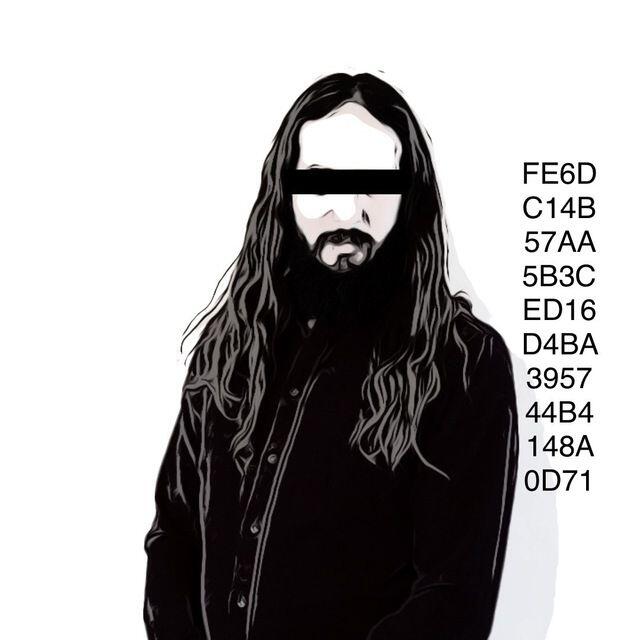 @ econoalchemist
2025-04-22 17:26:44
@ econoalchemist
2025-04-22 17:26:44A monthly newsletter by The 256 Foundation

April 2025
Introduction:
Welcome to the fourth newsletter produced by The 256 Foundation! March was an action-packed month with events ranging from the announcement of TSMC investing in US fabs to four solo block finds. Dive in to catch up on the latest news, mining industry developments, progress updates on grant projects, Actionable Advice on updating a Futurebit Apollo I to the latest firmware, and the current state of the Bitcoin network.
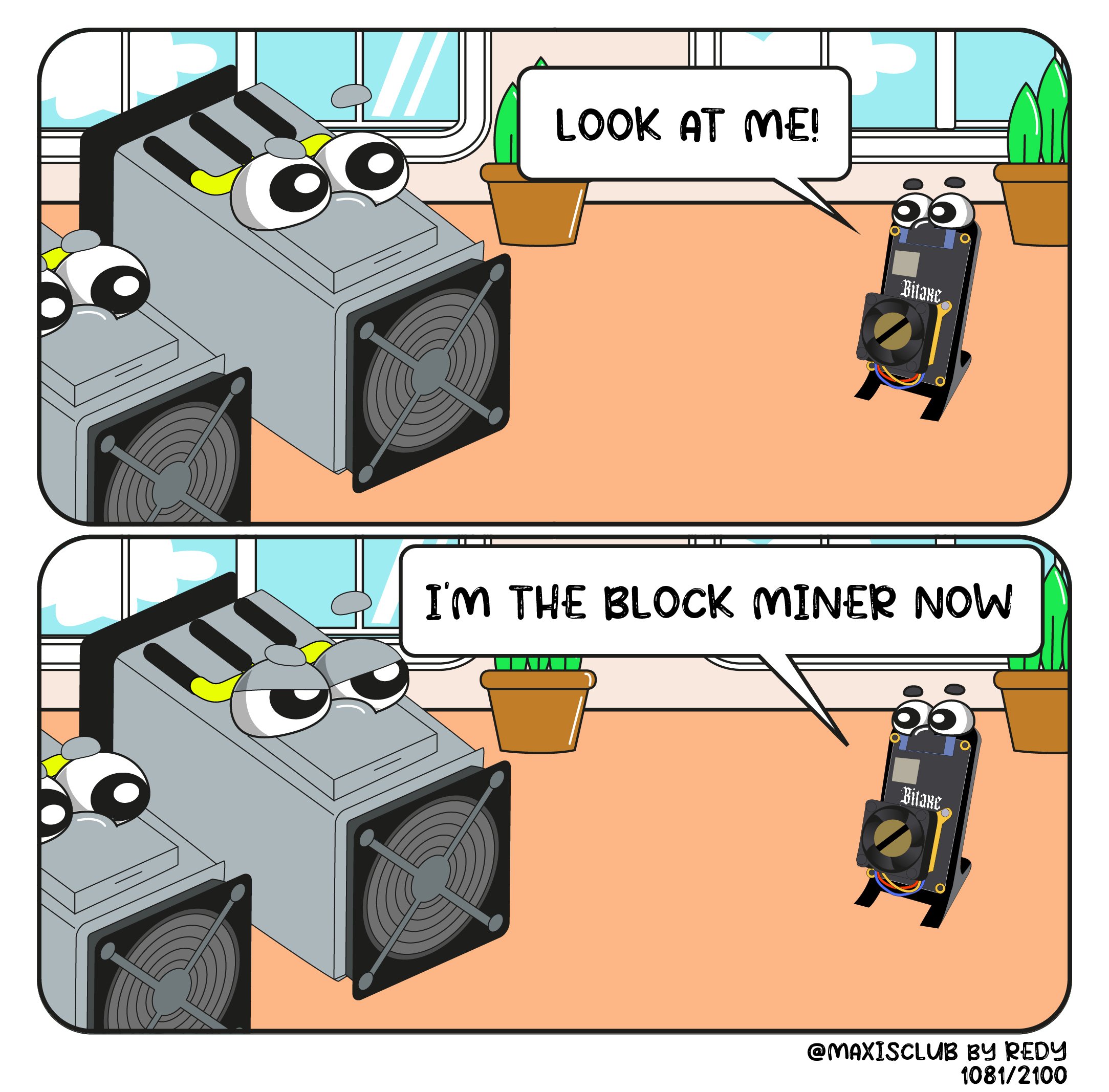
[IMG-001] Variation of the “I’m the captain now” meme by @maxisclub
Definitions:
MA = Moving Average
Eh/s = Exahash per second
Ph/s = Petahash per second
Th/s = Terahash per second
T = Trillion
J/Th = Joules per Terahash
$ = US Dollar
OS = Operating System
SSD = Solid State Drive
TB = Terabyte
News:
March 3, Ashigaru releases v1.1.1. Notable because this fork of Samourai Wallet serves as the remaining choice of mobile Bitcoin wallet capable of making peer to peer collaborative transactions. Not the Whirlpool transactions that Samourai Wallet was well-known for but the Stowaway and StonewallX2 p2p CoinJoin transactions. The persistence of Samourai’s tools still working despite the full force of the State coming down on the developers is a testament to the power of open-source code.
March 3, Stronghold completes cleanup of decommissioned coal plant using Bitcoin miners. Stronghold’s initiative counters the narrative that Bitcoin mining is wasteful by removing 150,000 tons of coal waste, part of a broader effort that cleared 240,000 tons in Q2 2024 alone. Waste coal piles in Pennsylvania, like the one in Russellton, have scarred landscapes, making this reclamation a significant step for local ecosystems. The project aligns with growing efforts in the region, as The Nature Conservancy also leads restoration projects in Pennsylvania to revive forests and waters. Stronghold’s dual-use model—powering Bitcoin miners and supplying the grid—shows how Bitcoin mining can support environmental goals while remaining economically viable.
March 3, five TSMC semiconductor fabs coming to Arizona. TSMC’s $100 billion investment in Arizona reflects a strategic push to bolster U.S. semiconductor production amid global supply chain vulnerabilities and geopolitical tensions, particularly with West Taiwan’s claims over Taiwan. TSMC’s existing $65 billion investment in Phoenix, now totaling $165 billion, aims to create 40,000 construction jobs and tens of thousands of high-tech roles over the next decade. This could relieve bottlenecks in ASIC chip supply if Bitcoin mining chip designers can get access to the limited foundry space. If that is the case, this could help alleviate some centralization concerns as it relates to a majority of Bitcoin mining chips coming from Taiwan and West Taiwan.
March 10, Block #887212 solved by a Bitaxe Ultra with ~491Gh/s. Not only did the Bitaxe satisfy the network difficulty, which was 112.15T, but obliterated it with a whopping 719.9T difficulty. This Block marked the second one solved by a Bitaxe and an increasing number of solo block finds overall as more individuals choose to play the Bitcoin lottery with their hashrate.
March 12, Pirate Bay co-founder, Carl Lundström, killed in plane crash. The Pirate Bay, launched in 2003, revolutionized online file-sharing by popularizing BitTorrent technology, enabling millions to access music, movies, and software, often in defiance of legal systems, which led to Lundström’s 2009 conviction for copyright infringement. The timing of his death coincides with ongoing global debates over digital ownership and intellectual property, often echoing many of the same themes in open-source technology, underscoring the enduring impact of The Pirate Bay’s challenge to traditional media distribution models.
March 18, Samourai Wallet status conference update. This was a short meeting in which the dates for the remaining pre-trial hearings was discussed.
- May 9, Opening Motion. - June 6, prosecution response to the opening motion. - June 20, defense replies to the prosecution response. - July 15, prosecution provides expert disclosure - August 8, defense provides expert disclosure - Tdev is able to remain home during the remaining pre-trial hearings so that he doesn’t have to incur the expenses traveling back and forth between Europe and the USDespite seemingly positive shifts in crypto-related policies from the Trump administration, all signs point to the prosecution still moving full steam ahead in this case. The defense teams need to be prepared and they could use all the financial help they can get. If you feel compelled to support the legal defense fund, please do so here. If the DOJ wins this case, all Bitcoiners lose.
March 18, DEMAND POOL launches, transitioning out of stealth mode and making room for applicants to join the private waiting list to be one of the Founding Miners.
Key features of DEMAND Pool include: • Build your own blocks • SLICE payment system & new mempool algorithm • No more empty blocks • End-to-end encryption for protection • Efficient data transfer, less wasted hashrate • Lower costs on CPU, bandwidth, & time
DEMAND Pool implements Stratum v2 so that miners can generate their own block templates, entering the arena of pools trying to decentralize mining such as OCEAN with their alternative to Stratum v2 called DATUM. A benefit of the Stratum v2 protocol over Stratum v1 is that data sent between the miner and the pool is now encrypted whereas before it was sent in clear-text, the encryption helps with network level privacy so that for example, your Internet Service Provider cannot read what is in the data being passed back and forth. Although, unless there is a proxy between your miner and the pool then the ISP may be able to determine that you are sending data to a mining pool, they just wouldn’t be able to tell what’s in that data. Overall, decentralization has become a buzz word lately and while it is a step in the right direction that more pools are enabling miners to decide which transactions are included in the block templates they work on, the pools remain a centralized force that ultimately can reject templates based on a number of reasons.
March 20, Bitaxe makes the cover of Bitcoin Magazine’s The Mining Issue, solidifying the Bitaxe as a pop-culture icon. Even those who disregard the significance of the Bitaxe project must recognize that the project’s popularity is an indication that something big is developing here.
 [IMG-002] Bitcoin Magazine, The Mining Issue
[IMG-002] Bitcoin Magazine, The Mining IssueMarch 21, self-hosted solo miner solves block #888737 with a Futurebit Apollo, making this the third solo block find for Futurebit. The first Futurebit Apollo block find may have been a fluke, the second a coincidence, but the third is an indication of a pattern forming here. More hashrate is being controlled by individuals who are constructing their own blocks and this trend will accelerate as time goes on and deploying these devices becomes easier and less expensive. This was the second solo block found in March.
March 21, US Treasury Department lifts sanctions on Tornado Cash. This is a positive sign coming from the US Treasury, however the charges against the Tornado Cash developer, Roman Storm, still stand and his legal defense team is still fighting an uphill battle. Even though the US Treasury removed Tornado Cash from the OFAC list, the department is attempting to stop a Texas court from granting a motion that would ensure the Treasury can’t put Tornado Cash back on the OFAC list. Meanwhile, the other Tornado Cash developer, Alex Pertsev, is fighting his appeal battle in the Dutch courts.
March 22, Self-hosted Public Pool user mines Block #888989. This was the first block mined with the Public Pool software, which is open-source and available for anyone to host themselves, in this case hosted on the user’s Umbrel. If you read the January issue of The 256 Foundation newsletter, there are detailed instructions for hosting your own instance of Public Pool on a Raspberry Pi. Easier solutions exist and accomplish the same thing such as Umbrel and Start9. This was the third solo block mined in March.
March 26, DeFi Education Fund publishes coalition letter urging congress to correct the DOJ’s dangerous misinterpretation of money transmission laws. In their own words: “First seen in Aug 2023 via the criminal indictment of @rstormsf, the DOJ’s novel legal theory expands criminal liability to software developers, ignoring longstanding FinCEN guidance and threatening the entire U.S. blockchain & digital asset ecosystem”. Many familiar organizations in the industry signed the letter, such as Coinbase, Kraken, A16z Crypto, and Ledger. Sadly, no Bitcoin companies signed the letter, highlighting the reckless ignorance prevalent among the “toxic Bitcoin maximalists” who often pride themselves on their narrow focus; a focus which is proving to be more of a blind spot limiting their ability to recognize a clear and present threat. The full letter text can be found here.
March 28, Heatbit reveals the black Heatbit, an elegant space heater that mines Bitcoin. Heat re-use applications such as Bitcoin mining space heaters are one of many examples where energy spent on generating heat can also earn the user sats. Other popular solutions include heating hot tubs, hotels, drive ways, and more. The innovations in this area will continue to be unlocked as open-source solutions like the ones being developed at The 256 Foundation are released and innovators gain more control over their applications.
March 29, miner with 2.5Ph/s solves Block #889975 with Solo CK Pool, marking the fourth solo block found in the month of March. This was the first solo block found on CK Pool’s European server. This was a good way to finish the month on a strong note for small-scale miners.
Free & Open Mining Industry Developments:
The development will not stop until Bitcoin mining is free and open. Innovators didn’t let off the gas in March, here are eleven note-worthy events:
0) @BTC_Grid demonstrates heating a new residential build with Bitcoin miners. This custom build features 6,000 square feet of radiant floors, 1,500 sqft of snow melting slab, 2 heated pools, all powered by Bitcoin miners and fully automated. Innovations and efficient systems like this will become more common as Bitcoin mining hardware and firmware solutions become open-source
1) @DrydeGab shares The Ocho, a Bitaxe Nerd Octaxe open-source Bitcoin miner featuring 8x BM1370 ASICs that performs at 9-10Th/s consuming ~180W. The Ocho runs on it’s own custom AxeOS. Currently out of stock but generally available for purchase in the IX Tech store.
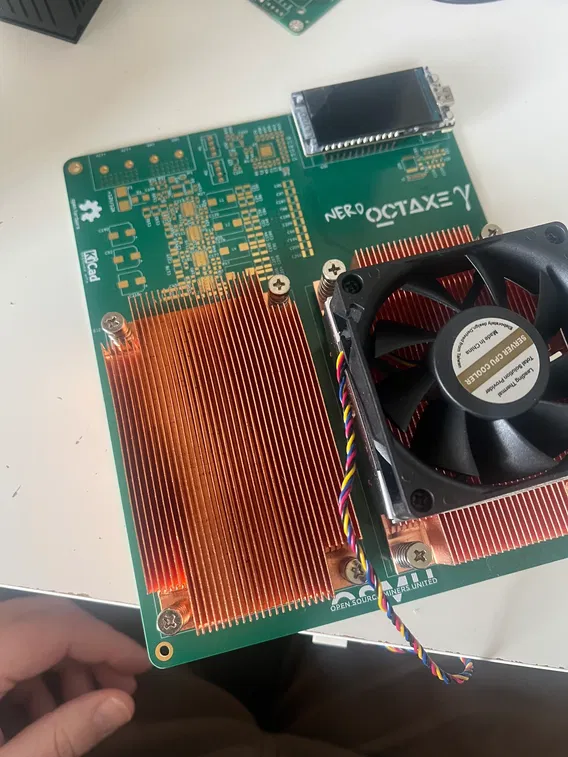 [IMG-003] The Nerd OCTAXE Ocho by @DrydeGab
[IMG-003] The Nerd OCTAXE Ocho by @DrydeGab2) @incognitojohn23 demonstrates building a Bitaxe from scratch with no prior experience, proving that anyone can access this technology with a little determination and the right community. @incognitojohn23 has also uploaded several videos documenting his progress and lessons along the way. Every builder has their first day, don’t hold back if you feel compelled to jump in and get started.
3) @HodlRev demonstrating how he combines Bitcoin mining with maple syrup production. In fact, @HodlRev has integrated Bitcoin mining into several aspects of his homestead. Be sure to follow his content for an endless stream of resourceful ideas. Once open-source Bitcoin mining firmware and hardware solutions become widely available, innovators like @HodlRev will have more control over every parameter of these unique applications.
4) ATL Bitlab announces their first hackathon, running June 7 through July 6. Promoted as “A global hackathon focused on all things bitcoin mining”. If you are interested in joining the hackathon, there is a Google form you can fill out here. It will be interesting to see what innovations come from this effort.
5) @100AcresRanch builds touchscreen dashboard for Bitaxe and Loki Boards. With this, you can control up to 10 mining devices with the ability to instantly switch any of the presets without going into the mining device UI.
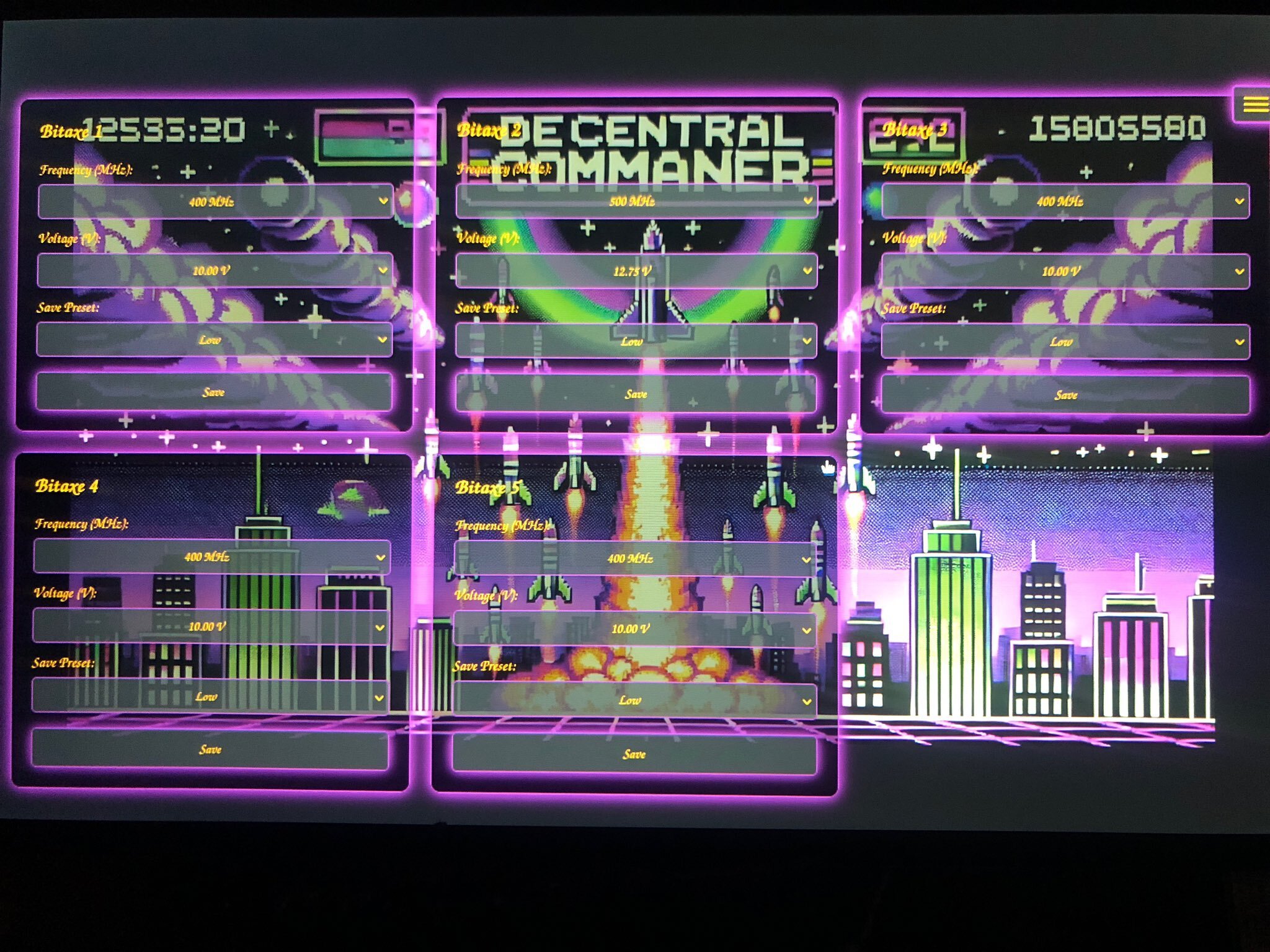 [IMG-004] Decentral Command Dashboard by @100AcresRanch
[IMG-004] Decentral Command Dashboard by @100AcresRanch6) @IxTechCrypto reveals HAXE, the newest member of the Nerdaxe miner family. HAXE is a 6 ASIC miner performing at ~7.4 Th/s at ~118W. Upon looking at the IX Tech store, it seems as though the HAXE has not hit shelves yet but keep an eye out for announcements soon.
7) Solo Satoshi reveals the NerdQaxe++, the latest marvel in the world of open-source Bitcoin mining solutions. This device is equipped with four ASIC chips from the Antminer S21 Pro and boasts an efficiency rating of 15.8 J/Th. At the advertised power consumption of 76 Watts, that would produce nearly 5 Th/s. Currently out of stock at the Solo Satoshi store and the IX Tech store but in stock and available at the PlebSource store.
8) @TheSoloMiningCo shares a bolt-on voltage regulator heatsink for the Bitaxe, this is a helpful modification when overclocking your miner and helps dissipate heat away from the voltage regulator. Many innovators are discovering ways to get every bit of efficiency they can from their hardware and sharing their ideas with the wider community for anyone to adopt.
9) @boerst adds historical data to stratum.work, a public website that monitors mining pool activity through calling for the work templates being generated for the pool’s respective miners. By parsing the information available in the work templates, a number of interesting observations can be made like which pools are merely proxies for larger pools, timing analysis of when templates are sent out, and now historical data on what the state of each pool’s templates were at a given block height. The work Boerst is doing with this website provides a great tool for gaining insights into mining centralization.
10) Braiins open-sources the BCB100 Control Board, designed to work with Antminers, this control board project has two parts: the hardware and the software. For the hardware part, open files include the Bill Of Materials, schematics, Gerbers, and CAD files. For the software part, open files include the board-level OpenWrt-based firmware with the full configuration file and the Nix environment for reproducible builds. The mining firmware binaries for bosminer and boser (same as the official Braiins OS releases) are also available to download and use to compile the image for the control board, however the Braiins OS firmware itself is not included in this open-source bundle. Braiins chose the GPLv3 open-source license for the software and the CERN-OHL-S open-source license for the hardware. This is a great gesture by Braiins and helps validate the efforts of The 256 Foundation to make Bitcoin mining free and open. The Braiins GitHub repositories where all this information can be found are accessible here and here. The 256 Foundation has plans to develop a Mujina firmware that can be flashed onto the BCB100 helping target Antminer machines.
Grant Project Updates:
In March, The 256 Foundation formalized agreements with the lead developers who were selected for each project. These agreements clearly defined the scope of each project, identified the deliverables, set a timeline, and agreement on compensation was made. Below are the outlines for each project, the compensation is not made public for privacy and security reasons.
Ember One:
@skot9000 instigator of the Bitaxe and all around legend for being the first mover in open-source Bitcoin mining solutions is the lead engineer for the Ember One project. This was the first fully funded grant from The 256 Foundation and commenced in November 2024 with a six month duration. The deliverable is a validated design for a ~100W miner with a standardized form factor (128mm x 128mm), USB-C data connection, 12-24v input voltage, with plans for several versions – each with a different ASIC chip. The First Ember One features the Bitmain BM1362 ASIC, next on the list will be an Ember One with the Intel BZM2 ASIC, then an Auradine ASIC version, and eventually a Block ASIC version. Learn more at: https://emberone.org/
Mujina Mining Firmware:
@ryankuester, embedded Linux developer and Electrical Engineer who has mastered the intersection of hardware and software over the last 20 years is the lead developer for the Mujina project, a Linux based mining firmware application with support for multiple drivers so it can be used with Ember One complete mining system. The grant starts on April 5, 2025 and continues for nine months. Deliverables include:
Core Mujina-miner Application: - Fully open-source under GPLv3 license - Written in Rust for performance, robustness, and maintainability, leveraging Rust's growing adoption in the Bitcoin ecosystem - Designed for modularity and extensibility - Stratum V1 client (which includes DATUM compatibility) - Best effort for Stratum V2 client in the initial release but may not happen until later
Hardware Support:
- Support for Ember One 00 hash boards (Bitmain chips) - Support for Ember One 01 hash boards (Intel chips) on a best effort basis but may not happen until later - Full support on the Raspberry Pi CM5 and IO board running the Raspberry Pi OS - Support for the Libre board when released - Best-effort compatibility with other hardware running LinuxManagement Interfaces:
• HTTP API for remote management and monitoring • Command-line interface for direct control • Basic web dashboard for status monitoring • Configuration via structured text files • Community Building and Infrastructure • GitHub project organization and workflow • Continuous integration and testing framework • Comprehensive user and developer documentation • Communication channels for users and developers • Community building through writing, podcasts, and conference participationThe initial release of Mujina is being built in such a way that it supports long-term goals like ultimately evolving into a complete Linux-based operating system, deployable through simple flashing procedures. Initially focused on supporting the 256 Foundation's Libre control boards and Ember hash boards, Mujina's modular architecture will eventually enable compatibility with a wide variety of mining hardware from different manufacturers. Lean more at: https://mujina.org/
Libre Board:
@Schnitzel, heat re-use maximalist who turned his home's hot water accessories into Bitcoin-powered sats generators and during the day has built a successful business with a background in product management, is the lead engineer on the Libre Board project; the control board for the Ember One complete mining system. Start date is April 5, 2025 and the deliverables after six months will be a mining control board based on the Raspberry Pi Compute Module I/O Board with at least the following connections:
• USB hub integration (maybe 10 ports?) • Support for fan connections • NVME expansion • Two 100-pin connectors for the compute module • Ethernet port • HDMI port • Raspberrypi 40-pin header for sensors, switches, & relays etc. • MIPI port for touchscreen • Accepts 12-24 VDC input power voltage.The initial release of Libre Board is being built in such a way that it supports long-term goals like alternative compute modules such as ARM, x86, and RISC-V. Learn more at: https://libreboard.org/
Hydra Pool:
@jungly, distributed systems PhD and the lead developer behind P2Pool v2 and formerly for Braidpool, now takes the reigns as lead developer for Hydra Pool, the stratum server package that will run on the Ember One mining system. Start date for this project was on April 5, 2025 and the duration lasts for six months. Deliverables include:
• Talks to bitcoind and provides stratum work to users and stores received shares • Scalable and robust database support to save received shares • Run share accounting on the stored shares • Implement payment mechanisms to pay out miners based on the share accounting • Provide two operation modes: Solo mining and PPLNS or Tides based payout mechanism, with payouts from coinbase only. (All other payout mechanism are out of scope of this initial release for now but there will be more). • Rolling upgrades: Tools and scripts to upgrade server with zero downtime. • Dashboard: Pool stats view only dashboard with support to filter miner payout addresses. • Documentation: Setup and other help pages, as required.The initial release of Hydra Pool is being built in such a way that it supports long-term goals like alternative payout models such as echash, communicating with other Hydra Pool instances, local store of shares for Ember One, and a user-friendly interface that puts controls at the user's fingertips, and supports the ability for upstream pool proxying. Learn More at: https://hydrapool.org/
Block Watcher:
Initially scoped to be a Bitcoin mining insights application built to run on the Ember One mining system using the self-hosted node for blockchain data. However, The 256 Foundation has decided to pause Block Watcher development for a number of reasons. Primarily because the other four projects were more central to the foundation’s mission and given the early stages of the Foundation with the current support level, it made more sense to deploy capital where it counts most.
Actionable Advice:
This month’s Actionable Advice column explains the process for upgrading the Futurebit Apollo I OS to the newer Apollo II OS and replacing the SSD. The Futurebit Apollo is a small mining device with an integrated Bitcoin node designed as a plug-and-play solution for people interested in mining Bitcoin without all the noise and heat of the larger industrial-grade miners. The Apollo I can hash between 2 – 4 Th/s and will consume roughly 125 – 200 Watts. The Apollo II can hash between 8 – 10 Th/s and will consume roughly 280 – 400 Watts. The motivation behind upgrading from the Apollo I OS to the Apollo II OS is the ability to run a stratum server internally so that the mining part of the device can ask the node part of the device for mining work, thus enabling users to solo mine in a self-hosted fashion. In fact, this is exactly what The 256 Foundation did during the Telehash fundraising event where Block #881423 was solo mined, at one point there was more than 1 Eh/s of hashrate pointed to that Apollo.
 [IMG-005] Futurebit Apollo I with new NVME SSD
[IMG-005] Futurebit Apollo I with new NVME SSDYou can find the complete flashing instructions on the Futurebit website here. You will need a separate computer to complete the flashing procedure. The flashing procedure will erase all data on the microSD card so back it up if you have anything valuable saved on there.
First navigate to the Futurebit GitHub Releases page at: https://github.com/jstefanop/apolloapi-v2/releases
Once there, you will see two OS images available for download, along with two links to alternative hosting options for those two images. If you are upgrading an Apollo I, you need to figure out which new OS image is right for your device, the MCU 1 image or the MCU 2 image. There are detailed instructions on figuring this out available here. There are multiple ways to determine if you need the MCU 1 or MCU 2 image. If the second to last digit in your Futurebit Apollo I is between 4 – 8 then you have an MCU 1; or if your batch number is 1 – 3 then you have an MCU 1; or if the circuit board has a 40-pin connector running perpendicular to the microSD card slot then you have an MCU 1. Otherwise, you have an MCU 2.
For example, this is what the MCU 1 circuit board will look like:
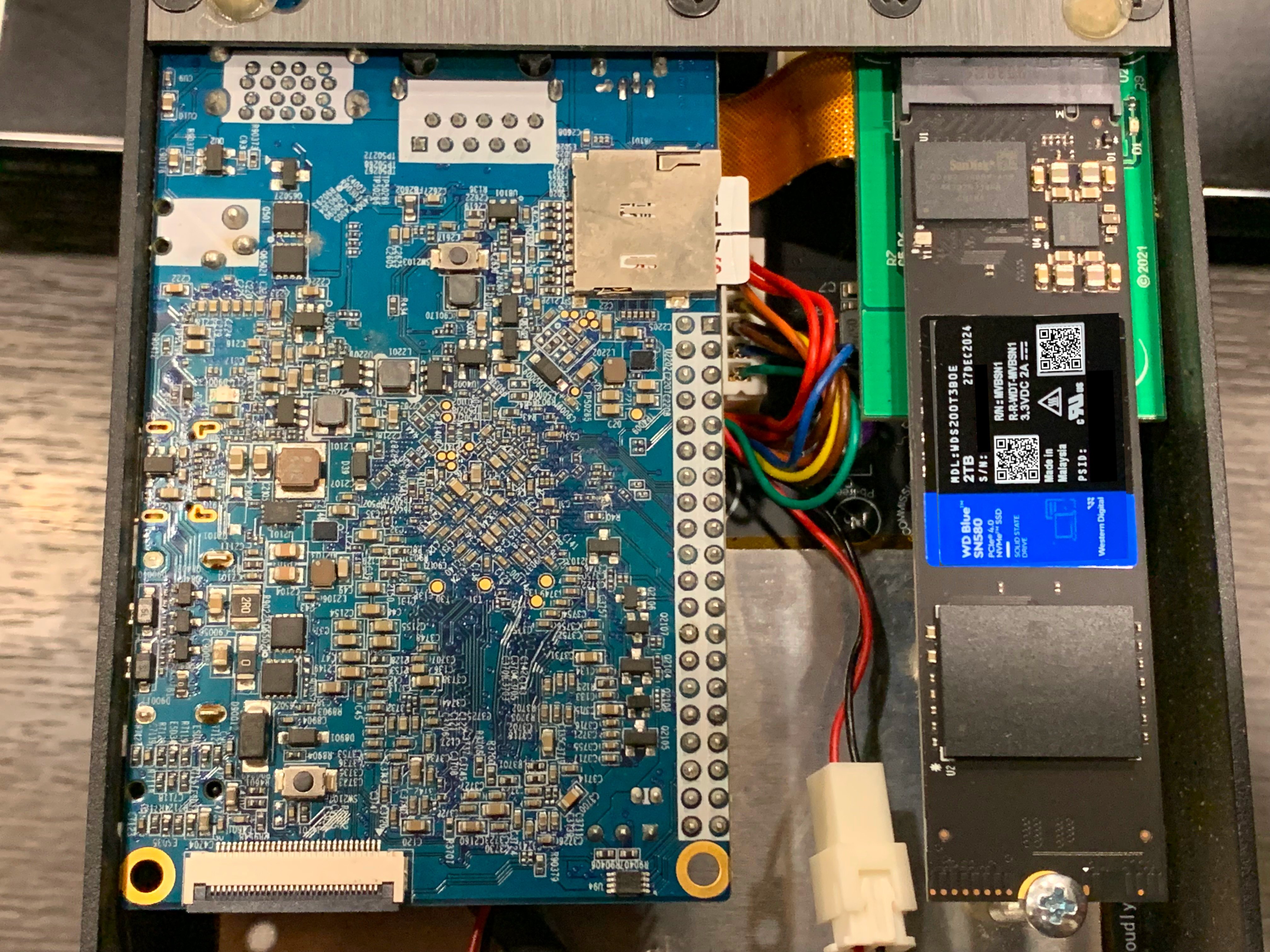 [IMG-006] Futurebit MCU1 example
[IMG-006] Futurebit MCU1 exampleOnce you figure out which OS image you need, go ahead and download it. The SHA256 hash values for the OS Image files are presented in the GitHub repo. If you’re running Linux on your computer, you can change directory to your Download folder and run the following command to check the SHA256 hash value of the file you downloaded and compare that to the SHA256 hash values on GitHub.
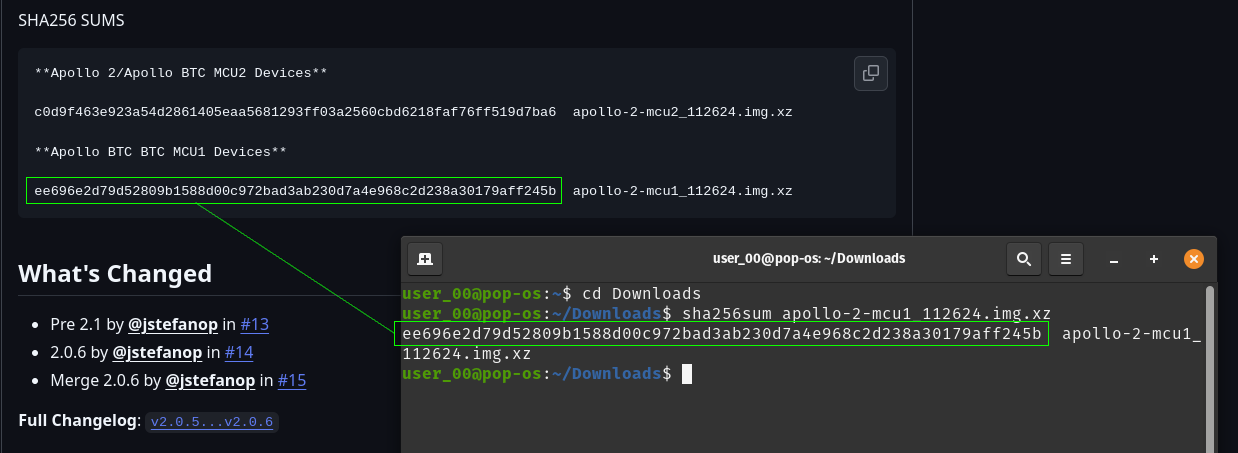 [IMG-007] Verifying Futurebit OS Image Hash Value
[IMG-007] Verifying Futurebit OS Image Hash ValueWith the hash value confirmed, you can use a program like Balena Etcher to flash your microSD card. First remove the microSD card from the Apollo circuit board by pushing it inward, it should make a small click and then spring outward so that you can grab it and remove it from the slot.
Connect the microSD card to your computer with the appropriate adapter.
Open Balena Etcher and click on the “Flash From File” button to define the file path to where you have the OS image saved:
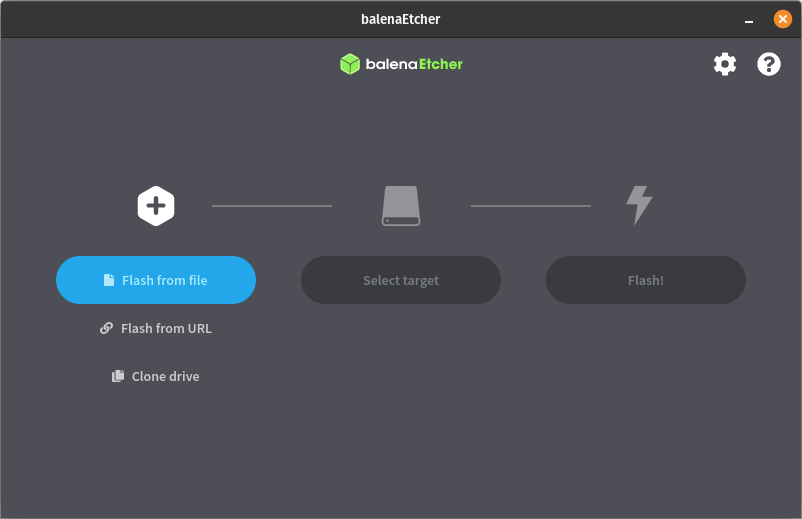 [IMG-008] Balena Etcher user interface
[IMG-008] Balena Etcher user interfaceThen click on the “Select Target” button to define the drive which you will be flashing. Select the microSD card and be sure not to select any other drive on your computer by mistake:
 [IMG-009] Balena Etcher user interface
[IMG-009] Balena Etcher user interfaceThen click on the “Flash” button and Balena Etcher will take care of formatting the microSD card, decompressing the OS image file, and flashing it to the microSD card.
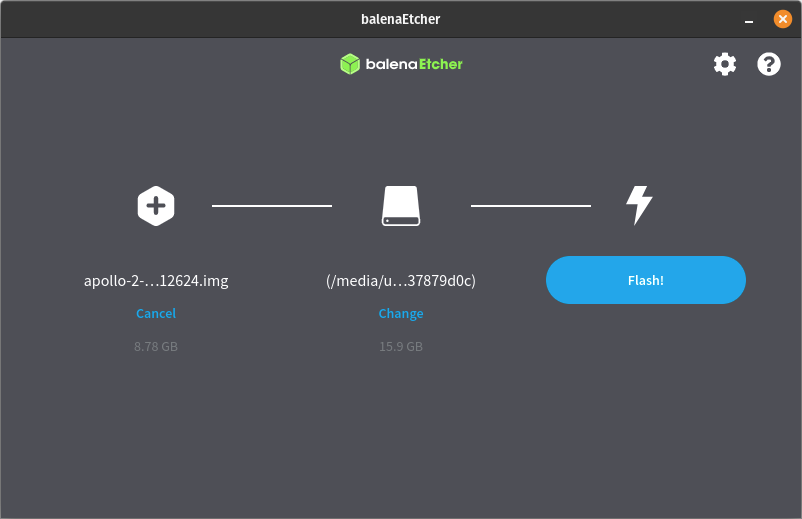 [IMG-010] Balena Etcher user interface.
[IMG-010] Balena Etcher user interface.The flashing process can take some time so be patient. The Balena Etcher interface will allow you to monitor the progress.
 [IMG-011] Balena Etcher user interface.
[IMG-011] Balena Etcher user interface.Once the flashing process is completed successfully, you will receive a notice in the balena Etcher interface that looks like this:
 [IMG-012] Balena Etcher user interface.
[IMG-012] Balena Etcher user interface.You can remove the microSD card from your computer now and install it back into the Futurebit Apollo. If you have an adequately sized SSD then your block chain data should be safe as that is where it resides, not on the microSD card. If you have a 1TB SSD then this would be a good time to consider upgrading to a 2TB SSD instead. There are lots of options but you want to get an NVME style one like this:
 [IMG-013] 1TB vs. 2TB NVME SSD
[IMG-013] 1TB vs. 2TB NVME SSDSimply loosen the screw holding the SSD in place and then remove the old SSD by pulling it out of the socket. Then insert the new one and put the screw back in place.
Once the SSD and microSD are back in place, you can connect Ethernet and the power supply, then apply power to your Apollo.
You will be able to access your Apollo through a web browser on your computer. You will need to figure out the local IP address of your Apollo device so log into your router and check the DHCP leases section. Your router should be accessible from your local network by typing an IP address into your web browser like 192.168.0.1 or 10.0.0.1 or maybe your router manufacturer uses a different default. You should be able to do an internet search for your specific router and figure it out quickly if you don’t already know. If that fails, you can download and run a program like Angry IP Scanner.
Give the Apollo some time to run through a few preliminary and automatic configurations, you should be able to see the Apollo on your local network within 10 minutes of powering it on.
Once you figure out the IP address for your Apollo, type it into your web browser and this is the first screen you should be greeted with:
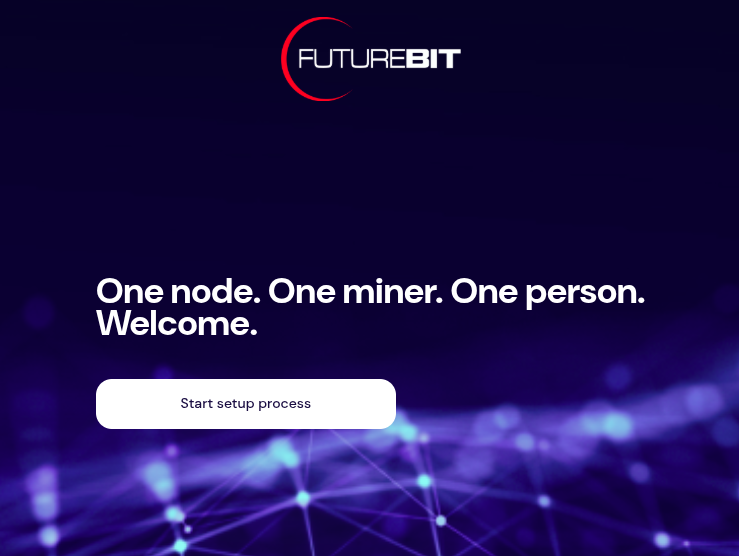 [IMG-014] Futurebit welcome screen
[IMG-014] Futurebit welcome screenClick on the button that says “Start setup process”. The next you will see should look like this:
 [IMG-015] Futurebit mining selection screen
[IMG-015] Futurebit mining selection screenYou have the option here to select solo mining or pooled mining. If you have installed a new SSD card then you should select pooled mining because you will not be able to solo mine until the entire Bitcoin blockchain is downloaded.
Your Apollo will automatically start downloading the Bitcoin blockchain in the background and in the mean-time you can start mining with a pool of your choice like Solo CK Pool or Public Pool or others.
Be forewarned that the Initial Blockchain Download (“IBD”) takes a long time. At the time of this writing, it took 18 days to download the entire blockchain using a Starlink internet connection, which was probably throttled at some points in the process because of the roughly 680 GB of data that it takes.
In February 2022, the IBD on this exact same device took 2 days with a cable internet connection. Maybe the Starlink was a bit of a bottleneck but most likely the extended length of the download can be attributed to all those JPEGS on the blockchain.
Otherwise, if you already have the full blockchain on your SSD then you should be able to start solo mining right away by selecting the solo mining option.
After making your selection, the Apollo will automatically run through some configurations and you should have the option to set a password somewhere in there along the way. Then you should see this page:
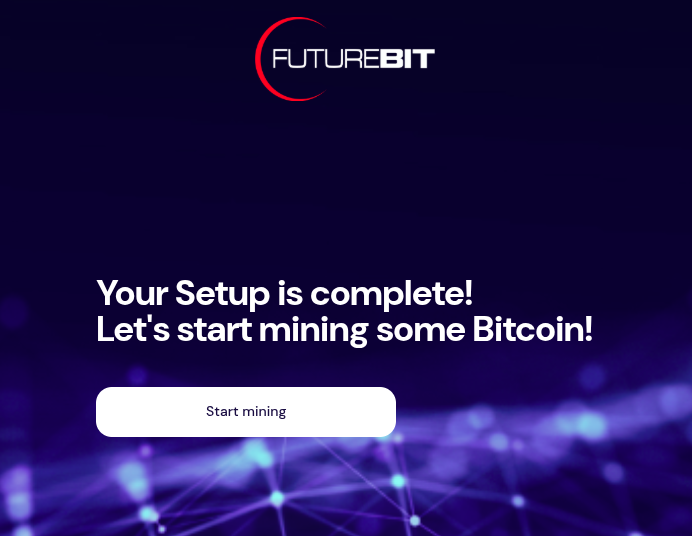 [IMG-016] Futurebit setup completion page
[IMG-016] Futurebit setup completion pageClick on the “Start mining” button. Then you should be brought to your dashboard like this:
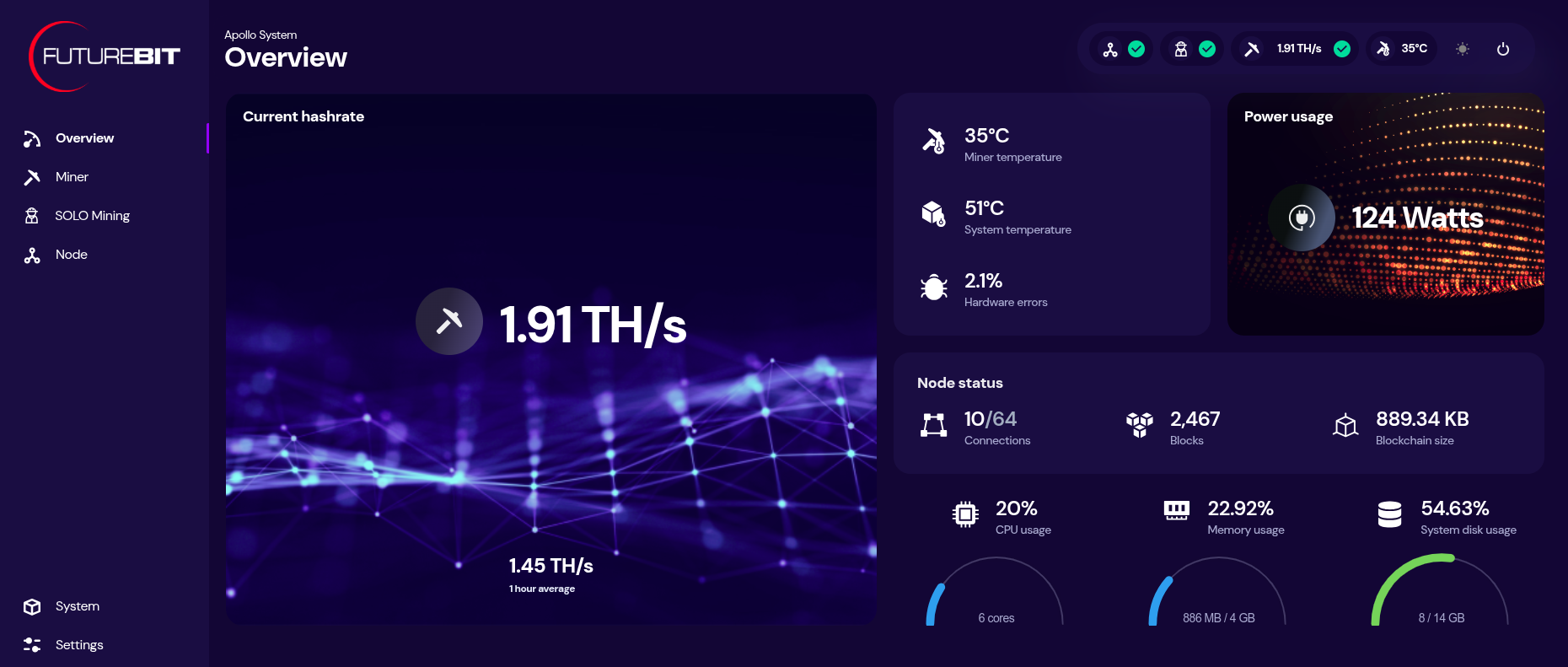 [IMG-017] Futurebit dashboard
[IMG-017] Futurebit dashboardYou can monitor your hashrate, temperatures, and more from the dashboard. You can check on the status of your Bitcoin node by clicking on the three-circle looking icon that says “node” on the left-hand side menu.
 [IMG-018] Futurebit node page
[IMG-018] Futurebit node pageIf you need to update the mining pool, click on the “settings” option at the bottom of the left-hand side menu. There you will see a drop down menu for selecting a pool to use, you can select the “setup custom pool” option to insert the appropriate stratum URL and then your worker name.
Once your IBD is finished, you can start solo mining by toggling on the solo mode at the bottom of the settings page. You will have a chance to update the Bitcoin address you want to mine to. Then click on “save & restart”.
 [IMG-019] Futurebit mining pool settings
[IMG-019] Futurebit mining pool settingsThen once your system comes back up, you will see a banner at the top of the dashboard page with the IP address you can use to point any other miners you have, like Bitaxes, to your own self-hosted solo mining pool!
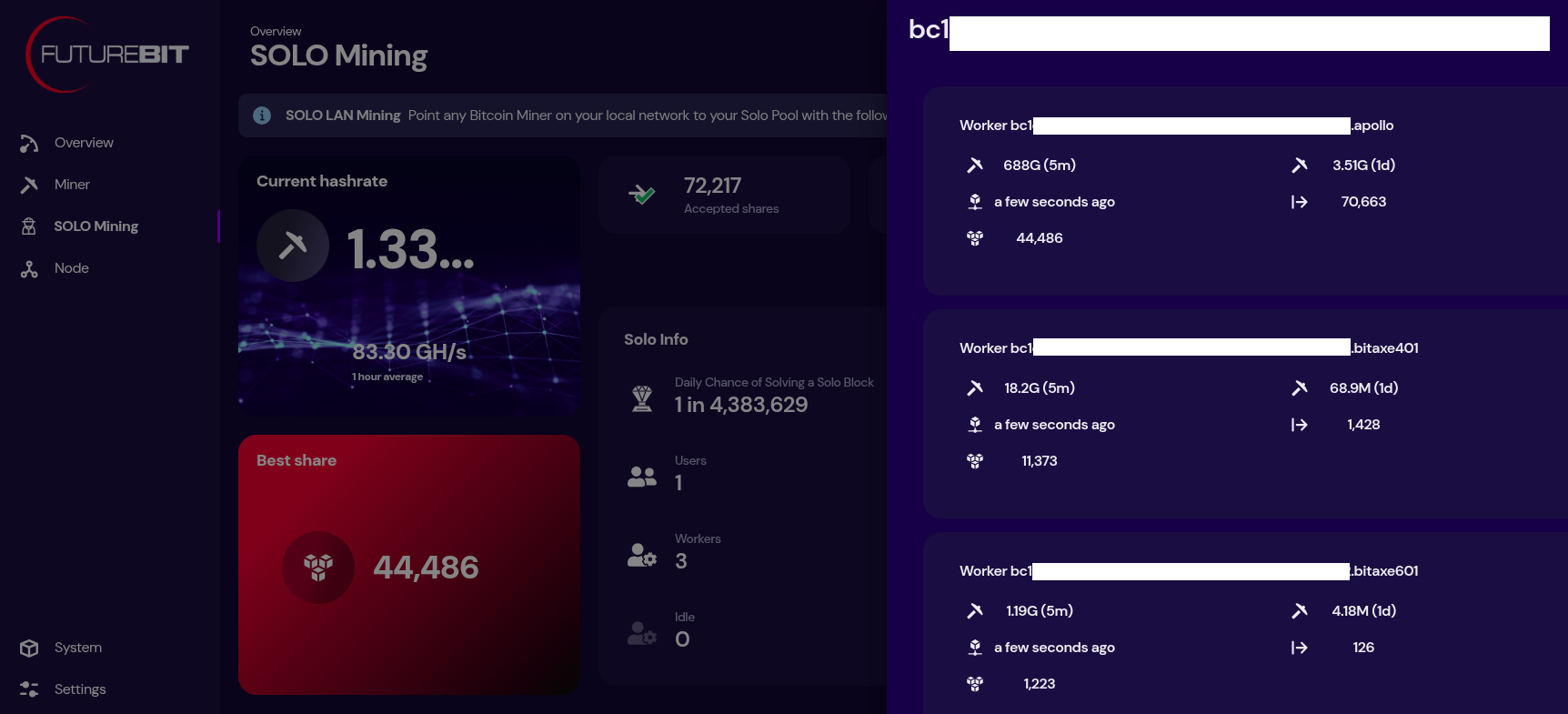 [IMG-020] Futurebit solo mining dashboard
[IMG-020] Futurebit solo mining dashboardNow just sit back and enjoy watching your best shares roll in until you get one higher than the network difficulty and you mine that solo block.
State of the Network:
Hashrate on the 14-day MA according to mempool.space increased from ~793 Eh/s to ~829 Eh/s in March, marking ~4.5% growth for the month.
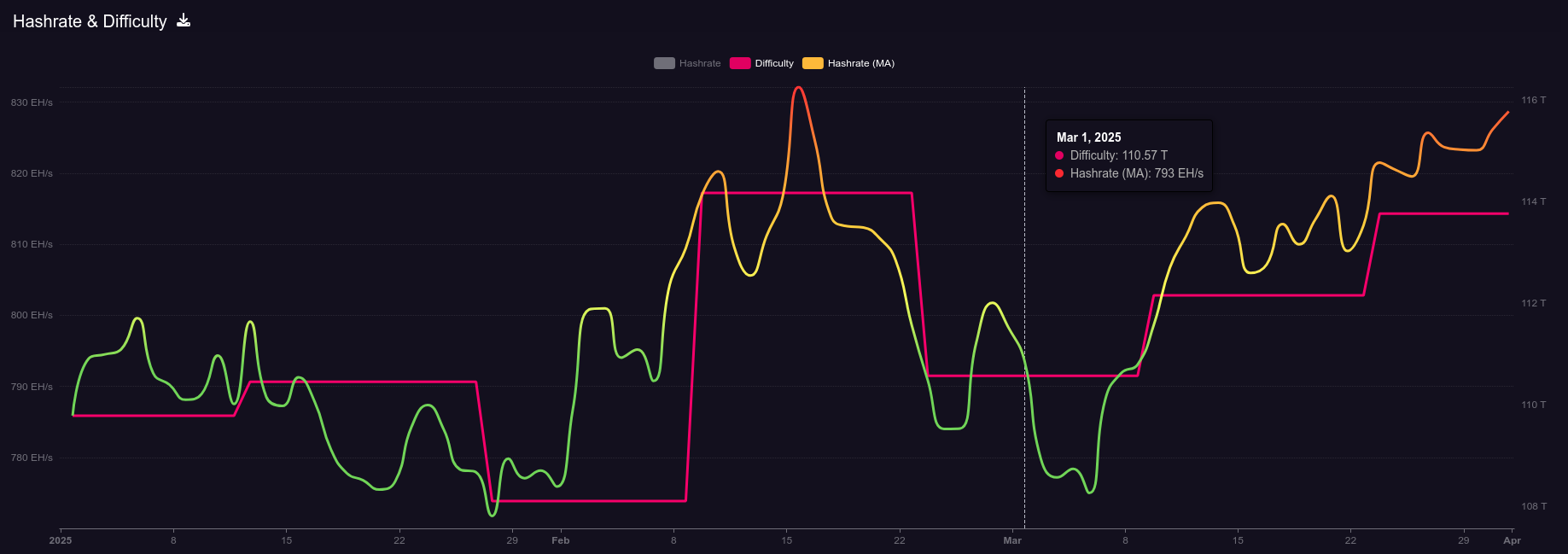 [IMG-021] 2025 hashrate/difficulty chart from mempool.space
[IMG-021] 2025 hashrate/difficulty chart from mempool.spaceDifficulty was 110.57T at it’s lowest in March and 113.76T at it’s highest, which is a 2.8% increase for the month. All together for 2025 up until the end of March, difficulty has gone up ~3.6%.
According to the Hashrate Index, more efficient miners like the <19 J/Th models are fetching $17.29 per terahash, models between 19J/Th – 25J/Th are selling for $11.05 per terahash, and models >25J/Th are selling for $3.20 per terahash. Overall, prices seem to have dropped slightly over the month of March. You can expect to pay roughly $4,000 for a new-gen miner with 230+ Th/s.
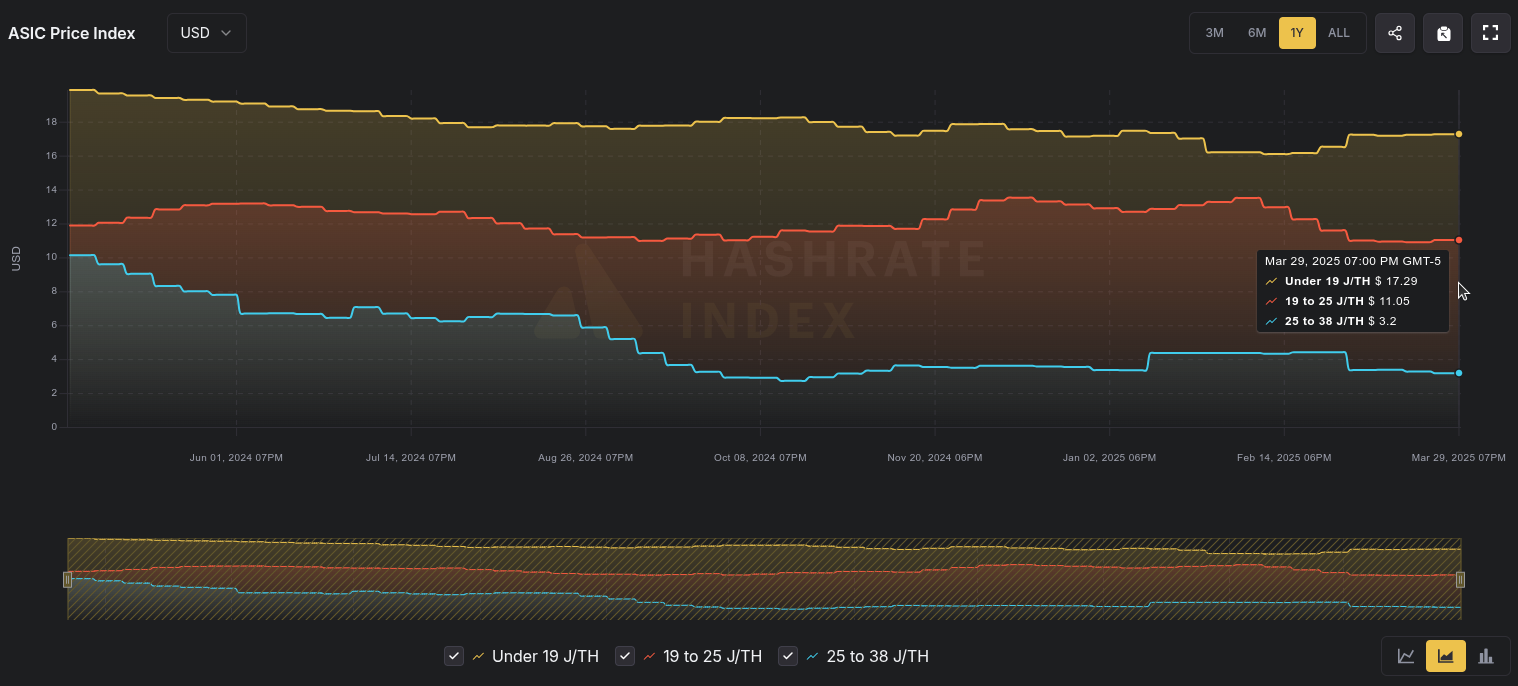 [IMG-022] Miner Prices from Luxor’s Hashrate Index
[IMG-022] Miner Prices from Luxor’s Hashrate IndexHashvalue is closed out in March at ~56,000 sats/Ph per day, relatively flat from Frebruary, according to Braiins Insights. Hashprice is $46.00/Ph per day, down from $47.00/Ph per day in February.
 [IMG-023] Hashprice/Hashvalue from Braiins Insights
[IMG-023] Hashprice/Hashvalue from Braiins InsightsThe next halving will occur at block height 1,050,000 which should be in roughly 1,071 days or in other words ~156,850 blocks from time of publishing this newsletter.
Conclusion:
Thank you for reading the third 256 Foundation newsletter. Keep an eye out for more newsletters on a monthly basis in your email inbox by subscribing at 256foundation.org. Or you can download .pdf versions of the newsletters from there as well. You can also find these newsletters published in article form on Nostr.
If you haven’t done so already, be sure to RSVP for the Texas Energy & Mining Summit (“TEMS”) in Austin, Texas on May 6 & 7 for two days of the highest Bitcoin mining and energy signal in the industry, set in the intimate Bitcoin Commons, so you can meet and mingle with the best and brightest movers and shakers in the space.
While you’re at it, extend your stay and spend Cinco De Mayo with The 256 Foundation at our second fundraiser, Telehash #2. Everything is bigger in Texas, so set your expectations high for this one. All of the lead developers from the grant projects will be present to talk first-hand about how to dismantle the proprietary mining empire.
 IMG-024] TEMS 2025 flyer
IMG-024] TEMS 2025 flyerIf you have an old Apollo I laying around and want to get it up to date and solo mining then hopefully this newsletter helped you accomplish that.
 [IMG-026] FREE SAMOURAI
[IMG-026] FREE SAMOURAIIf you want to continue seeing developers build free and open solutions be sure to support the Samourai Wallet developers by making a tax-deductible contribution to their legal defense fund here. The first step in ensuring a future of free and open Bitcoin development starts with freeing these developers.
You can just FAFO,
-econoalchemist